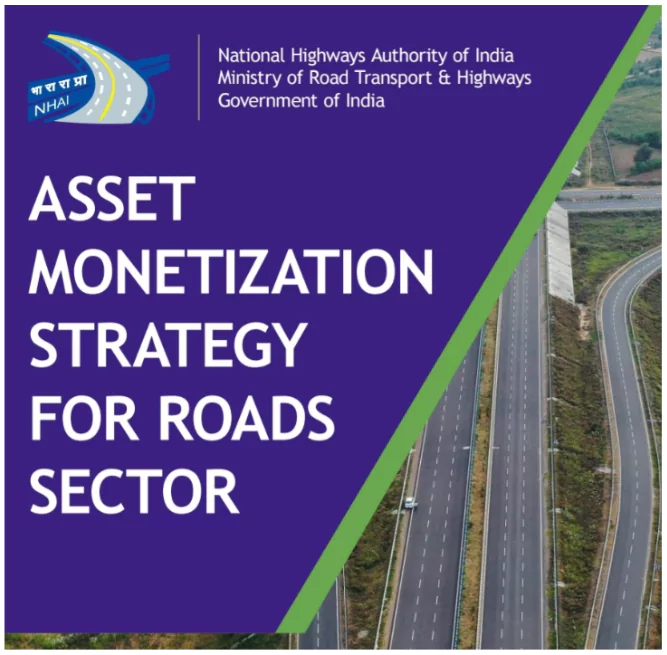The National Highways Authority of India (NHAI) has released its first Asset Monetisation Strategy for the Road Sector, aiming to boost capital generation through Public-Private Partnership (PPP) models.
Key Objectives of the Strategy
- Unlock the economic value of operational highways.
- Attract private sector investment to improve efficiency and innovation.
- Ensure a steady stream of funds for infrastructure development without over-relying on traditional budgetary sources.
Three Pillars of the Strategy

- Value Maximisation of Assets: Scientific identification and evaluation of monetisable road assets.
- Ensures maximum returns through competitive bidding and market-based pricing.
- Transparency & Information Dissemination: Clear frameworks and disclosure of relevant data to investors.
- Market Development & Stakeholder Engagement: Expansion of the investor base.
Monetisation Models Adopted by NHAI
- Toll-Operate-Transfer (ToT): Long-term leasing of operational toll roads to private players against upfront payment.
- Infrastructure Investment Trusts (InvITs): Allows retail and institutional investors to invest in infrastructure projects and earn returns.
- Securitisation of Toll Revenues: Monetising future cash flows from toll collections by issuing bonds or loans backed by toll receipts.
Asset Monetisation
- Asset Monetisation refers to the process of unlocking the economic value of public sector assets by involving private sector investment and participation.
- It means converting idle or underutilized public assets into sources of revenue, typically through models like lease, concession, or investment trusts.
- Example: NHAI leasing operational highways to private players under the ToT model is a classic case of asset monetisation.
- Purpose:
-
- Raise capital for new infrastructure projects.
- Improve efficiency in asset management.
- Reduce burden on public finances.
Global best practices in Asset Monetization
- Transparency: Australia has an Asset Recycling Initiative, which mandates transparent bidding and reinvestment of proceeds into new infrastructure .
- Instruments of monetization: U.S. and Singapore use REITs/InvITs for infrastructure funding, while Japan leverages hybrid rail models .
- AI & Blockchain: Used in U.S. infrastructure for predictive maintenance and transparent transactions .
- Data Monetization: High-quality data platforms (e.g., Google Cloud Analytics) enhance asset value .
- Reinvestment for Sustainable Growth: Australia’s Asset Recycling Fund mandates reinvestment, creating a self-sustaining cycle.
|
Significance of Asset Monetization in India’s Road Sector
- Funds for New Infrastructure: Over ₹1.4 lakh crore already mobilised from 6,100+ km of national highways under the National Monetisation Pipeline (NMP).
- Reduces Government Debt: Shifts maintenance costs to private players, cutting fiscal burden.
- Boosts Private Investment: Encourages PPP through models like TOT, InvITs, attracting global investors (e.g., Brookfield, Macquarie).
- Improves Road Quality & Tech; Private operators bring better maintenance, tech, and efficiency, enhancing road longevity.
- Ensures Transparency & Trust: Structured framework with clear valuation and investor-friendly processes.
- Supports Sustainable Growth: Aligns with India’s 2025-30 Monetisation Plan, ensuring long-term financing for highways.
Challenges in Asset Monetization of Road Sector
- Underbidding & Low Investor Interest: Private players may offer lower-than-expected bids in TOT (Toll-Operate-Transfer) auctions, reducing revenue potential.
- Economic slowdowns or policy uncertainties can also deter investor participation.
- Regulatory & Legal Hurdles: Land acquisition disputes, environmental clearances, and contract enforcement delays can slow down monetization.
- Frequent changes in tolling policies or tax structures create uncertainty for investors.
- Asset Quality & Maintenance Risks: Poor condition of some highways reduces their monetization appeal.
- As per a CAG Report (2023), nearly one fourth of NHAI’s road assets identified for monetisation required major rehabilitation, impacting investor confidence.
- Market & Financial Risks: Fluctuations in traffic volumes (due to economic conditions or alternate routes) affect toll revenues.
- Rising interest rates make financing costlier for private players, reducing their willingness to invest.
- Public Resistance & Political Opposition: Toll hikes or privatization of highways can trigger public backlash.
- State governments may oppose central-led monetization of key routes due to political or regional concerns.
- Limited Investor Base for New Models: Instruments like InvITs (Infrastructure Investment Trusts) require deep capital markets, which are still developing in India.
Way Forward
- Expand & Diversify Monetization Models: Scale up innovative models like InvITs (Infrastructure Investment Trusts) and TOT (Toll-Operate-Transfer) while exploring hybrid structures (e.g., securitization, SPVs).
- Strengthen Investor Confidence Through Transparency: Implement standardized asset valuation, clear contract terms, and real-time performance tracking via an Asset Monetisation Dashboard (proposed in Budget 2021-22)
- The Delhi-Noida Direct Flyway TOT succeeded because of transparent bidding, fetching $1.45 billion.
- Optimize Concession Periods & Risk-Sharing: Offer flexible tenures (e.g., 20–30 years) and revenue-sharing mechanisms to balance investor returns and public interest.
- Prioritize High-Traffic Corridors & Tech Integration: Monetize high-density routes (e.g., Delhi-Mumbai Expressway) and integrate FASTag, RFID, and AI-based tolling to boost revenue.
- Establish Robust Dispute Resolution Mechanisms: Fast-track arbitration and adopt NITI Aayog’s proposal to bring InvITs under the Insolvency and Bankruptcy Code (IBC).
- Delays in land acquisition and toll disputes (e.g., Pune-Mumbai Expressway) have stalled projects.
Conclusion
NHAI’s strategy marks a paradigm shift in infrastructure financing, promoting transparency, private investment, and efficient asset management. As an early adopter of innovative monetisation mechanisms, NHAI is setting a precedent for sustainable infrastructure development across India.
![]() 12 Jun 2025
12 Jun 2025


